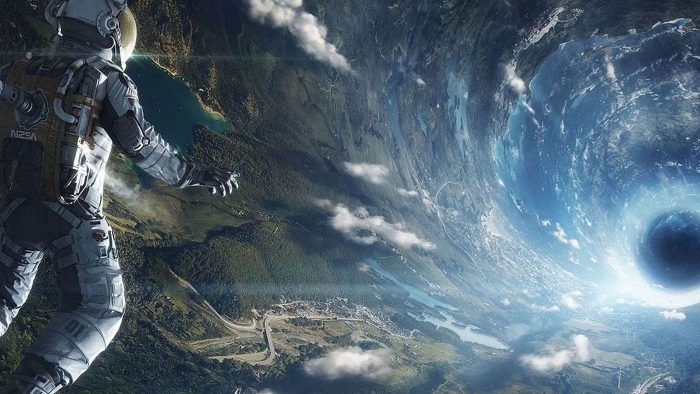Christopher Nolan’s Interstellar isn’t just a space adventure. It’s a film built on real physics — and then stretched by imagination. With Nobel-winning physicist Kip Thorne as adviser, the story tries to stay as close to science as possible, even when it dives into black holes and fifth dimensions.
The ending, where Cooper falls into Gargantua and somehow sends a message across time, has kept scientists debating for years. Could any of that really happen? This piece breaks it down — what’s real, what’s theoretical, and what’s pure storytelling — to see just how far Interstellar goes beyond the edge of known physics.
Inside Gargantua — The Science of Survival
At the heart of Interstellar’s finale lies a single scientific decision: the kind of black hole Cooper falls into. If Gargantua were small, he’d never make it. A stellar-mass black hole would tear any object apart long before reaching the centre. The difference in gravity between head and feet would stretch a body into atoms — a process scientists call “spaghettification.”
But Gargantua is supermassive — millions of times heavier than our Sun. Its event horizon is vast, and the pull of gravity changes more gently across that distance. In theory, a ship could cross the boundary intact without even realising it.
Nolan and Thorne made one more crucial choice: Gargantua spins. A rotating black hole, known as a Kerr black hole, doesn’t crush everything into a single point. Its centre forms a thin, ring-shaped singularity that might, at least mathematically, be avoidable. Some equations even suggest a passage through it could lead elsewhere — another region of spacetime, maybe even another universe.
In real physics, that’s where things get shaky. The “inner horizon” of such a black hole would likely be unstable, filled with radiation and violent energy. Anything falling in would be destroyed instantly. The film sidesteps this problem — assuming a future version of physics, perhaps quantum gravity, might one day make the journey survivable.

Beyond the Event Horizon — Higher Dimensions and Brane Cosmology
To explain how Cooper can send a message from inside a black hole, the film reaches for a real but speculative branch of physics called brane cosmology. The idea is simple but radical: our universe, with its three dimensions of space and one of time, isn’t the whole picture. It might just be a “membrane” — or brane — floating in a larger five-dimensional space known as the bulk.
In this model, most forces — light, electromagnetism, and the particles that make up matter — are stuck on our 4D brane. They can’t move through the higher dimension. Gravity, however, is different. Because it’s a property of spacetime itself, it can spread out through the bulk. Some physicists think this could explain why gravity feels so weak compared to other forces: it’s “leaking” into the extra dimension.
That’s the loophole Interstellar uses. Cooper isn’t breaking the laws of physics by sending a signal out of a black hole. Instead, he’s using gravity — the one force that can slip through the fifth dimension — to reach another point in spacetime. In the film, that point happens to be his daughter Murph’s bedroom, many years earlier.
It’s an elegant narrative move: the science stays just within the bounds of real theory, but the outcome belongs entirely to storytelling.
The Tesseract — Architecture of Time
Once inside Gargantua, Cooper finds himself in the tesseract — the most abstract and emotional part of Interstellar. It’s not meant to be a natural place. It’s a kind of machine, built by future humans who’ve learned to live in higher dimensions. Its purpose is simple: to help a three-dimensional mind see and move through time as if it were space.
The tesseract visualises time as an endless grid of Murph’s bedroom. Each layer shows a different moment in her life — every second of that room’s existence stacked together. By moving through this structure, Cooper can pick a specific instant and interact with it.
The film’s rules stay consistent here: light can travel into the tesseract from our universe, but not out. That’s why Murph can’t see her father. Gravity, though, isn’t limited by that barrier. It can cross dimensions. Cooper uses it to push books from the shelf and move the second hand of the watch — turning abstract physics into a physical act of love.
This sequence is where Interstellar shifts from science toward poetry. Yet the logic behind it still rests on real physics: if gravity connects all dimensions, it could be the bridge between worlds — or between moments in time.
They Are Us — Closing the Causal Loop
The final reveal ties science and philosophy into one idea: the mysterious “they” who built the wormhole aren’t aliens at all — they’re us. Humanity, far in the future, has evolved beyond four dimensions and learned to shape spacetime itself. They reached back through time to save their own ancestors, completing the loop that allows them to exist in the first place.
It’s a classic bootstrap paradox — an event that creates itself. The wormhole exists because future humans built it, yet those future humans only exist because the wormhole saved humanity. On paper, that sounds impossible. But the film resolves it through Einstein’s block universe concept: time isn’t a flowing line, it’s a solid structure where every moment — past, present and future — coexists. Nothing is changed; it’s all already there.
Within that framework, Interstellar’s loop isn’t a contradiction. It’s self-consistent. Cooper was always meant to fall into Gargantua. Murph was always meant to solve the equation. The timeline doesn’t bend — it closes, perfectly.
Between Science and Speculation
The ending of Interstellar stands on a line between what we know and what we hope to understand. Some parts are solid physics: time slows near a massive body, a supermassive black hole could be crossed without instant death, and Gargantua’s glowing ring of light was modelled using real equations — so precise it led to a published scientific paper.
Other parts are educated guesses. The idea of surviving the inner horizon, communicating through gravity in higher dimensions, or existing inside a tesseract all belong to serious but unproven theories. They’re not fantasy — they’re possibilities waiting for better mathematics or future evidence.
And then there’s the film’s final leap — that love itself might be a measurable, guiding force across space and time. That’s not science; it’s metaphor. But it gives emotional meaning to everything that came before.
Nolan and Thorne didn’t invent new physics for Interstellar. They built a story at the edge of what physics allows — and where imagination takes over. The result isn’t a lie told by cinema, but a thought experiment about what might one day be possible when knowledge, technology and empathy evolve together.



